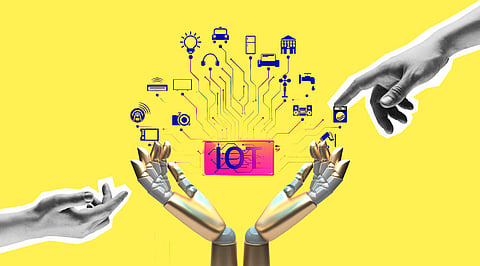

IoT and Machine Learning go hand in toward a smart future Understanding the merging of two cutting-edge tools is part of the learning process way a company functions. By transforming massive amounts of data into useful insights and decision-making tools, IoT machine learning has transformed the way companies function. The technological age is continuously evolving, with breakthroughs appearing almost every day. The combination of the Internet of Things IoT and Machine Learning in 2023 is one such area that has recently acquired enormous popularity (ML).
This innovative combination of technologies is creating new business possibilities and is set to play a significant role in shaping our world's future. In an increasingly data-driven world, IoT machine learning offers a new and exciting avenue for companies to harness the power of big data and obtain a competitive advantage in the market of IoT and Machine Learning for a Smart Future
An idea IoT machine learning: The idea behind IoT machine learning is to combine the strengths of both technologies to introduce a new degree of automation, optimization, and intelligence to a variety of sectors. Organizations can gain useful insights, make educated decisions, and drive innovation by utilizing the enormous quantities of data produced by IoT devices and using algorithms that use machine learning to evaluate and understand it. The combination of IoT and machine learning can transform how companies function, how goods are developed and manufactured, and how services are provided, resulting in better client experiences and higher operational efficiency.
How do IoT and machine intelligence operate together?
IoT and machine learning tools complement each other powerfully, with IoT devices producing massive amounts of data that machine learning algorithms can evaluate to gain insights and fuel innovation. Organizations can automate processes, increase productivity, and make data-driven choices in real time by integrating these tools.
Machine learning's involvement in IoT: Machine learning algorithms can improve IoT device capabilities by allowing them to process and evaluate data in real-time and perform steps based on the insights obtained. Organizations can improve their efficiency, automate processes, and make data-driven choices on the periphery by embedding machine learning models into IoT devices, decreasing the need for cloud-based processing and latency.
The advantages of IoT machine learning: The integration of IoT and machine learning technologies provides numerous advantages to companies in a variety of sectors.
Enhanced business productivity: used to automate a variety of corporate operations, freeing up time and resources for other duties. Predictive maintenance in production, for example, employs machine learning algorithms to anticipate when machinery requires repair, decreasing delay and increasing productivity.
Predictive upkeep and improved data processing: Machine learning algorithms can analyze massive amounts of data produced by IoT devices, giving useful insights that can be used to make decisions. Predictive maintenance, which predicts machinery failure and reduces downtime, is one example of how machine learning can be used to better company results.
Decision-making and problem-solving in real-time: Organizations can make data-driven choices in real-time without human involvement by integrating machine learning algorithms into IoT devices. In agriculture, for example, IoT devices and machine learning algorithms can be used to maximize irrigation and fertilizer utilization in real-time, increasing agricultural harvests and decreasing waste.
Cost reductions and higher Returns: Predictive maintenance, for example, in manufacturing can reduce downtime and enhance machine efficiency, resulting in cost savings and improved output. Finally, the integration of machine learning and IoT technologies provides many advantages that can enhance company productivity, decision-making, and cost savings. Organizations across multiple industries are already reaping these advantages, and the pattern is expected to continue as technology advances.
Machine learning applications in different sectors: The combination of IoT and machine learning has numerous uses in a variety of sectors. This combination of technologies enables real-time data processing and better decision-making, resulting in greater productivity and expense savings. Let's take a look at how IoT machine learning is being used in the sectors listed below.
Healthcare: This info can be used to identify and treat patients more, decreasing the need for in-person meetings and limiting the spread of disease. Wearable fitness trackers and smart inhalers powered by IoT can also provide useful data for machine learning algorithms to evaluate, allowing healthcare workers to make more educated choices.
Retail: can use IoT devices to watch inventory levels in real-time, allowing them to make data-driven choices about when to restock goods and reduce waste. Furthermore, algorithms based on machine learning can be used to evaluate customer buy patterns, allowing retailers to provide personalized product suggestions and increase total customer happiness.
Manufacturing: Machine learning algorithms, for example, can be used to evaluate data from IoT sensors on manufacturing equipment, enabling makers to find areas for development and make proactive repairs before equipment failures materialize. This can result in less downtime, higher output, and higher earnings.
Agriculture: In agriculture to increase agricultural harvests, reduce waste, and reduce the use of harmful pesticides. This can result in better crop growth, lower expenses, and higher earnings for producers.
Transportation and logistics industry: The transportation and logistics business. Machine learning algorithms, for example, can be used to evaluate data from GPS-enabled cars to optimize transportation routes and decrease gasoline usage.
Join our WhatsApp Channel to get the latest news, exclusives and videos on WhatsApp
_____________
Disclaimer: Analytics Insight does not provide financial advice or guidance. Also note that the cryptocurrencies mentioned/listed on the website could potentially be scams, i.e. designed to induce you to invest financial resources that may be lost forever and not be recoverable once investments are made. You are responsible for conducting your own research (DYOR) before making any investments. Read more here.
